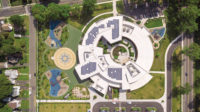Concordia International School, Shanghai, China, Perkins Eastman
Despite space and budget constraints, Concordia International School Shanghai embraces a community feeling.

Concordia’s expansion included construction of a new performing arts center, which contains a 400-seat recital hall.
Photo © Tim Griffith

Site Plan:
1) Performing arts center 2) Elementary school 3) High school 4) Middle school

Performing Arts Center, First Floor Plan:
1) Lobby 2) Band room 3) Black box theater 4) Scene shop 5) Dressing room

Elementary School, First Floor Plan: 1) Entrance 2) Commons 3) Motor skills 4) Administration 5) Classroom

The exterior of the performing arts center takes material cues from the adjacent high school, to which it connects by a skybridge. The generous use of glass in common spaces like the cafeteria enhance daylighting, as well as students’ sense of being outdoors.
Photo © Tim Griffith

The exterior of the performing arts center takes material cues from the adjacent high school, to which it connects by a skybridge. The generous use of glass in common spaces like the cafeteria enhance daylighting, as well as students’ sense of being outdoors.
Photo © Tim Griffith

A wide swath of terra-cotta brick differentiates the four-story elementary school from the existing high school.
Photo © Tim Griffith

Fine-arts students attend class at the rooftop studio and terrace of the performing arts center—an amenity school officials insisted upon.
Photo © Tim Griffith

Wood louvers mounted on the exterior of the performing arts center protect young musicians from excessive sunlight or glare.
Photo © Tim Griffith









Only in China, perhaps, is it possible for a private academy serving grades pre-kindergarten through 12 to construct an innovative 64,600-square-foot elementary school and a richly appointed 24,000-square-foot performing arts center in 18 months and for a scant $15 million.
The Concordia International School Shanghai opened these facilities, in 2007, as the first phase of a new campus master plan designed by the New York City-based firm Perkins Eastman. China’s inexpensive labor pool helped the school maximize its construction budget, but the design still underwent value engineering to cut costs. During this process a different sense of the word “value” guided Concordia: what Louise Schini Weber, a cofounder and principal of the elementary school, describes as a commitment to nurturing “cooperation and collaboration.”
Indeed, administrators refused to skimp on a performing arts center. Located in the southwest corner of the 10-acre campus, the trapezoidal-building connects to the high school to the east via a skybridge. Movable platforms and seating, as well as variable acoustics, enable its main volume to function as a 400-seat recital hall as well as a 335- or 300-seat thrust-stage theater. A rooftop studio opens onto a terrace for art classes whose aluminum-slatted canopy echoes the look of aluminum sunscreens throughout the campus’s south- and west-facing elevations.
“The terrace would have never survived the typical value engineering process in the U.S.,” observes Ron Vitale, AIA, managing principal of Perkins Eastman’s Shanghai office. “But the school’s board decided it was as important a space for teachers and students as it was for the community.”
Concordia’s commitment to community building is manifested strongly in the design of the elementary school, a D-shaped structure located at the campus’s southeast corner, opposite the performing arts center. The first and second grades, as well as the third and fourth grades, occupy the four-story building’s top floors in “paired” classrooms separated only by a partial wall. “In a classroom with four walls and a door, other teachers don’t know what you’re doing,” Weber explains, “but in a paired classroom, collaboration is unavoidable.”
There’s another, prosaic reason the elementary school feels so intimate. Wetlands surrounded Concordia when it opened in 1998. But just as enrollment grew from 22 students to more than 1,000—nearly three-quarters of whom are the children of U.S. and Canadian citizens—foreign business executives moved to the vicinity and the swampland was developed into a residential enclave. Only half the 20 acres that Concordia initially wanted were still available when it began master planning in 2006. It was further constrained by municipal building codes requiring plenty of open space.
To maximize available real estate, Perkins Eastman went vertical, replacing a previous low-rise structure with the four-story school. Vitale’s team also pushed unexpected uses of routine spaces. In addition to the rooftop arts terrace, for instance, Concordia features two playgrounds on the roof of the elementary school. Corridors, meanwhile, do double duty as social hubs and extra instruction areas: At wider points, these pathways contain tables, chairs, and whiteboards.
Generous fenestration maintains a sense of connectivity to the outdoors and interior spaces. Glass walls and windows enclose the elementary school’s ground-floor cafeteria. A large opening connects this dining and assembly space to a gymnasium, where glass garage doors along the west elevation open during pleasant weather. Daylighting is the design’s primary sustainable strategy, Vitale says, although phase two of the master plan includes adding a partial green roof during renovations to the high school.
Teachers say that having access to a variety of sun-filled rooms is critical. “Shanghai’s weather and air quality are terrible, and it is dreary and yellow a lot of the time,” explains Stephanie Herdrich, an instructional coach. “Moving kids from space to space inside, with so much daylight everywhere, almost feels like going outdoors. It has a huge effect on students and teachers.” The building’s material palette also lifts spirits.
Mostly clad in glass and zinc panels to match the existing high school (designed by Perkins Eastman’s predecessor on campus, Perkins+Will), the exteriors of the new elementary school and performing arts center feature warmer accents, such as horizontal wood-louver screens and terra-cotta bricks. “When the sun hits the terra-cotta in the morning, it gives you a feeling like, ‘Please come inside, you’re going to be loved when you walk in the door,’” Weber says—an important message for every school to convey.














